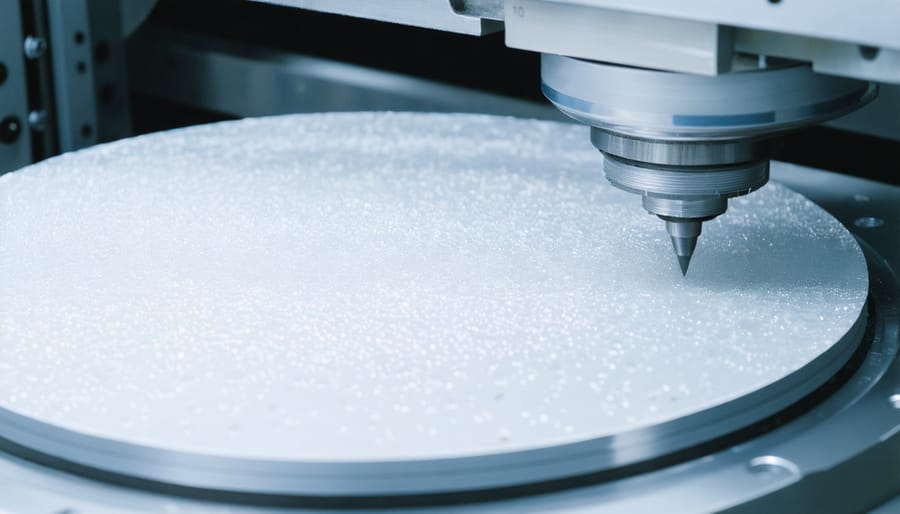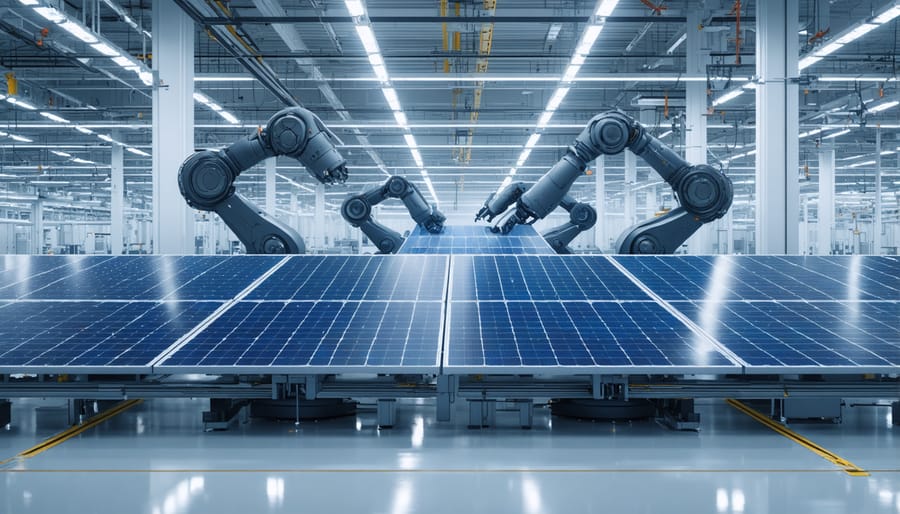Smart Supply Chain Tactics That Boost Solar Panel Performance

Revolutionize solar panel performance through strategic supply chain optimization and cutting-edge efficiency measures. Advanced material selection, incorporating latest-generation photovoltaic cells and anti-reflective coatings, delivers up to 23% higher energy conversion rates across European installations. Precision-engineered manufacturing processes, leveraging automated quality control and standardized testing protocols, ensure consistent panel performance while reducing production defects by 40%. Smart logistics networks, utilizing real-time tracking and regional distribution hubs, slash transportation costs and carbon emissions while maintaining strict quality standards throughout the supply chain.
Innovative installation techniques, combined with IoT-enabled monitoring systems, maximize energy capture by adapting to local climate conditions and maintaining optimal panel orientation. This comprehensive approach to solar panel optimization has demonstrated a 30% increase in overall system efficiency across diverse European markets, from Mediterranean solar farms to Nordic rooftop installations. Industry leaders implementing these strategies report significant improvements in both energy output and long-term reliability, establishing new benchmarks for sustainable energy production.
Material Selection and Quality Control
Advanced Silicon Procurement
The foundation of high-performance solar panels lies in the quality of silicon used in their production. European manufacturers are increasingly focusing on ultra-pure silicon procurement, recognizing its crucial role in developing advanced solar cell technology. This grade of silicon, with purity levels exceeding 99.999%, significantly enhances photovoltaic efficiency and overall panel performance.
Strategic partnerships with leading silicon refineries across Europe have revolutionized the procurement process, ensuring consistent access to premium-grade materials. These relationships enable manufacturers to maintain strict quality controls while optimizing cost efficiency. Modern refinement techniques, including the advanced Siemens process and floating zone method, produce silicon crystals with minimal impurities and optimal electronic properties.
The impact of high-grade silicon on panel performance is substantial. Panels manufactured with superior silicon demonstrate up to 23% higher conversion efficiency compared to those using standard-grade materials. This improvement translates directly into enhanced energy generation capacity and longer panel lifespan, offering better return on investment for both residential and commercial installations.
Sustainable sourcing practices are increasingly important, with European suppliers implementing circular economy principles in silicon production. This approach not only ensures environmental responsibility but also helps stabilize supply chains and reduce dependency on external markets.

Quality Testing Protocols
Quality testing protocols form the backbone of solar panel optimization, ensuring consistent performance and reliability across production batches. The European Solar Test Installation (ESTI) standards serve as the primary framework, incorporating both laboratory and field testing methodologies that evaluate crucial performance parameters.
Key testing protocols include flash testing, which measures panel output under standardized test conditions (STC), and electroluminescence imaging that identifies micro-cracks and potential failure points. Environmental chamber testing subjects panels to accelerated aging conditions, simulating decades of exposure to various weather conditions in just weeks.
Materials undergo rigorous quality control, including UV resistance testing, mechanical load assessment, and thermal cycling evaluation. Advanced spectral response testing ensures optimal energy conversion across different wavelengths of light, while salt spray testing validates corrosion resistance for coastal installations.
Each production batch undergoes performance ratio verification, comparing actual versus theoretical energy yield. Quality assurance teams employ statistical process control (SPC) methods to maintain consistency and identify potential issues before they impact performance. Real-time monitoring systems track key metrics throughout the manufacturing process, enabling immediate adjustments when parameters deviate from established standards.
Independent certification bodies regularly audit these testing protocols, ensuring compliance with IEC and EN standards while validating the accuracy of internal quality control measures. This comprehensive approach to quality testing helps maintain the high performance standards expected in the European solar market.
Production Process Optimization
Automated Manufacturing Intelligence
The integration of smart manufacturing processes has revolutionized solar panel production, delivering unprecedented levels of quality control and consistency. Advanced automation systems now monitor every aspect of production, from silicon wafer cutting to final assembly, ensuring optimal performance in each panel that leaves the factory.
Machine learning algorithms analyze real-time data from multiple sensors, detecting microscopic defects that might escape human inspection. This intelligent quality control system can identify issues such as micro-cracks, imperfect soldering, or lamination inconsistencies before they become problematic. The result is a significant reduction in panel defects and improved overall efficiency ratings.
European manufacturers have particularly embraced automated testing protocols that subject panels to rigorous performance evaluations under various environmental conditions. These systems simulate different weather patterns, temperature variations, and light intensities to ensure consistent performance across all operating conditions.
The manufacturing intelligence extends to predictive maintenance, where AI-powered systems anticipate potential equipment failures before they occur, minimizing production disruptions and maintaining consistent output quality. This proactive approach has helped reduce manufacturing downtime by up to 30% in many European facilities.
Real-time production data analytics enable manufacturers to continuously optimize their processes, resulting in better resource utilization and reduced waste. The system automatically adjusts production parameters based on performance metrics, ensuring each panel meets or exceeds efficiency standards while maintaining cost-effectiveness.

Quality Control Integration
Modern solar panel production facilities integrate sophisticated quality control systems that monitor and adjust manufacturing processes in real-time. These advanced monitoring solutions employ artificial intelligence and machine learning algorithms to detect even minor deviations in production parameters, ensuring consistent panel quality throughout the manufacturing process.
Key components of these systems include high-resolution cameras that inspect cell alignment and soldering quality, thermal imaging systems that identify potential hot spots or defects, and electrical testing equipment that verifies performance parameters. The data collected is instantly analyzed, allowing for immediate adjustments to production settings when necessary.
European manufacturers have particularly embraced automated quality control systems, implementing Industry 4.0 principles to create smart factories. These facilities utilize sensor networks that monitor everything from material composition to environmental conditions, ensuring optimal production environments. Digital twin technology enables manufacturers to simulate and optimize production processes before implementation, reducing waste and improving efficiency.
Real-time monitoring extends beyond basic quality checks to include advanced spectral analysis of solar cells, ensuring optimal light absorption capabilities. Automated systems also track the uniformity of anti-reflective coatings and verify the structural integrity of panel frames and glass surfaces.
The integration of these quality control measures has significantly reduced defect rates while increasing production efficiency. Manufacturers can now identify and address potential issues before they affect the final product, resulting in more reliable and higher-performing solar panels. This systematic approach to quality control has become essential in meeting the growing demand for high-efficiency solar solutions across European markets.
Logistics and Storage Innovation
Environmental Control Systems
Maintaining optimal storage conditions for solar panels is crucial for preserving their efficiency and longevity throughout the supply chain. Temperature-controlled environments between 15-25°C prove ideal for preventing thermal stress on the panels’ materials, while humidity levels should be maintained between 35-45% to prevent moisture damage and potential delamination.
Modern warehousing facilities across Europe increasingly implement smart climate control systems that automatically adjust conditions based on real-time monitoring. These systems use IoT sensors to track environmental parameters and alert facility managers when conditions deviate from optimal ranges.
Proper panel positioning during storage is equally important. Vertical racking systems with adequate spacing prevent pressure points and reduce the risk of micro-cracks. Additionally, UV-protective coverings shield panels from excessive light exposure during extended storage periods, preventing premature degradation of the photovoltaic cells.
Dust management plays a vital role in maintaining panel quality. Advanced filtration systems and regular cleaning protocols ensure storage areas remain free from particulate matter that could compromise panel surfaces. Some facilities have implemented positive pressure systems to prevent dust infiltration.
For transport between storage facilities, climate-controlled containers equipped with shock absorption systems protect panels from temperature fluctuations and mechanical stress. This comprehensive approach to environmental control helps maintain panel efficiency from production to installation, ensuring optimal performance for end users.

Smart Transportation Solutions
The journey from production facility to installation site presents unique challenges for solar panel protection. Advanced transportation solutions have emerged to safeguard these sensitive components throughout their logistics journey across Europe. Custom-designed packaging systems, featuring impact-absorbing materials and moisture-resistant barriers, ensure panels maintain their integrity during transit.
Smart tracking systems integrated into transport containers monitor environmental conditions, including temperature, humidity, and vibration levels. This real-time data allows logistics teams to make immediate adjustments to protect the panels. Additionally, specialized handling equipment and loading protocols minimize physical stress during loading and unloading operations.
European transport regulations have shaped the development of innovative securing methods, such as air-cushioned suspension systems and climate-controlled containers. These solutions are particularly crucial when navigating varied terrain and weather conditions across different regions.
Multi-modal transportation strategies, combining rail, road, and sometimes maritime options, optimize delivery routes while minimizing handling risks. Professional logistics partners utilize route planning software to identify the safest and most efficient pathways, avoiding areas with excessive vibration or extreme weather conditions.
Quality control checkpoints throughout the journey ensure panels arrive in optimal condition. This comprehensive approach to transportation protection contributes significantly to the overall performance and longevity of solar installations, ultimately maximizing return on investment for European businesses and homeowners.
Installation Partner Network
A robust installation partner network plays a crucial role in maximizing solar panel performance after delivery. Throughout Europe, qualified installer networks have developed sophisticated systems to ensure optimal panel placement, configuration, and long-term maintenance.
These networks typically consist of certified professionals who undergo rigorous training in the latest solar technologies and installation techniques. Many leading manufacturers maintain strict certification requirements for their installation partners, ensuring consistent quality standards across different regions.
Installation partners provide comprehensive site assessments, taking into account factors such as roof orientation, shading patterns, and local weather conditions. This detailed analysis helps determine the ideal panel placement for maximum energy yield. They also consider structural requirements, ensuring that rooftops can safely support the solar array while maintaining building integrity.
Modern installation networks utilize advanced monitoring systems during and after installation. These systems allow for real-time performance tracking and swift identification of any efficiency issues. Many networks offer ongoing maintenance services, including regular inspections, cleaning schedules, and performance optimizations to maintain peak efficiency throughout the system’s lifetime.
Quality installation partners also provide valuable consultation services, helping clients understand their energy needs and system capabilities. They can recommend appropriate panel configurations, inverter types, and storage solutions based on specific usage patterns and local grid requirements.
In the European context, installation networks must comply with diverse regional regulations and grid connection requirements. Professional installers stay updated with local building codes, safety standards, and renewable energy incentives, ensuring installations meet all necessary compliance measures.
Most importantly, these networks serve as a crucial link between manufacturers and end-users, providing feedback that helps improve product design and installation methods. This collaborative approach has led to innovations in mounting systems, maintenance procedures, and performance monitoring tools, ultimately contributing to better solar panel optimization across the industry.
The optimization of solar panels in European markets requires a multifaceted approach that combines technical excellence with strategic supply chain management. As European solar innovation continues to advance, successful optimization strategies have emerged as key drivers of enhanced performance and reliability.
Material selection and quality control remain fundamental, with high-grade silicon and advanced coating technologies delivering measurable improvements in energy conversion efficiency. The implementation of smart monitoring systems and predictive maintenance protocols has proven crucial in maximizing panel lifespan and maintaining optimal performance levels throughout the system’s operational life.
Supply chain optimization has demonstrated significant impact through streamlined logistics networks and localized manufacturing facilities, reducing transportation costs while ensuring timely delivery of components. The integration of automated quality testing and standardized installation procedures has markedly improved overall system reliability and performance consistency.
These optimization strategies have collectively yielded impressive results: enhanced energy conversion rates of up to 23%, reduced installation times by 30%, and improved system longevity by an average of 5-7 years. For European stakeholders, this translates to more cost-effective solar solutions and accelerated return on investment timelines.
Moving forward, continued focus on these optimization techniques, coupled with emerging technologies and refined supply chain practices, will be essential for maintaining Europe’s position at the forefront of solar energy innovation and sustainability.
Leave a Reply